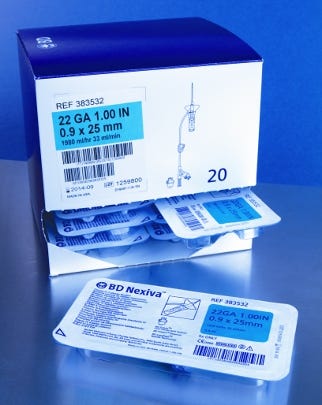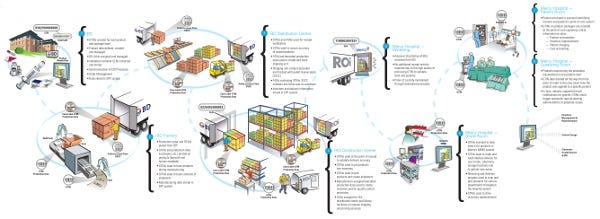
BD beauty shot
In a perfect world, there would be Perfect Order in our healthcare system, with no errors in the supply chain and ultimate patient safety.
With that goal in mind, medical device leader Becton, Dickinson and Co. (BD) implemented Perfect Order and, along the way, introduced an end-to-end supply chain packaging bar code system with its customer, Mercy Hospital, and Mercy's supply chain company, ROi (Resource Optimization & Innovation). The solution—described in the illustration—is the first known instance in the U.S. that a healthcare provider and a medical device manufacturer have used the Global Location Number (GLN) and Global Trade Item Number (GTIN) throughout both the supply chain and clinical processes.
Data synchronization
Defined by Strategic Marketplace Initiative (SMI), a consortium of healthcare supply-chain executives, "Perfect Order" is an ideal in healthcare that represents true electronic order processing, from order placement to delivery and payment, without human intervention.
BD laid much of the groundwork for this effort decades ago by implementing bar codes on its product packages. It eventually transitioned to GS1 global standards: GTINs and GLNs. Today, the company assigns GTINs to all products at three levels of packaging—primary (product), secondary (shelf cartons) and tertiary (shipping cases). Each subsequent level connects with the prior one in a child/parent/grandparent hierarchy. Some products are too small to accommodate a bar code, though, so codes would just appear on the secondary and tertiary packs for those products.

BD/Mercy/ROi illustration
BD has studied specific use cases with healthcare providers to ensure that the data imprinted in bar codes meets both clinical and supply chain needs. The tremendous diversity in products, package sizes and packaging materials prohibits using a one-size-fits-all solution to applying bar codes.
As of February 2011, BD established a voluntary data sync with Mercy/ROi keyed to the GTINs and GLNs embedded in linear Code 128 bar codes for nearly 500 products, such as syringes, catheters and specimen collection tubes. The data is managed through BD's enterprise resource planning (ERP) software from SAP and shared with Mercy/ROi via electronic data interchange (EDI) and integrated into its internal IT systems. This sharing took place—with help from EDI partner GHX and software vendor Lawson—only after BD had reconciled all unique product IDs in its own ERP Master Data file.
Dennis Black
Dennis Black, BD's director, e-Business, and point-man in the collaborative effort with Mercy/ROi, explains how atypical this data-sync is in the healthcare industry. Currently, many product manufacturer bar codes are covered up with other codes used at various points in the supply chain, which can cause errors and inefficiencies.
"What we were trying to do is enable the healthcare provider to get benefits from the bar codes that we put on product packages," Black says. "When we studied the failure points and challenges in the supply chain, we learned that many errors and inefficiencies were caused by the lack of data standards."
Through this successful case study with Mercy/ROi, BD is encouraging change in the industry. "It's our hope that this becomes the norm in the healthcare industry," Black says.
Printing processes
Before BD can share the data, it first has to be generated and then added to packages.
Vijay Krishnamurthi, director, worldwide packaging leader and manufacturing support for BD Medical-Medical Surgical Systems (the company's largest business unit), explains that the Master Data controls the online package printing, which is how the vast majority of bar codes are added to products. This is done on a secure network, with all BD locations having access to the company's ERP system.
Not all the products that ship to Mercy/ROi are produced in the U.S. (which was another reason BD went with the GS1 global product ID standard). BD has 40+ plants worldwide. Over the years, the company added some online printing capabilities, which quickly expanded as adding bar codes and other variable data become the norm. Andrew Stellon, manager, supply chain compliance at BD, says, "[Bar coding] accelerated the migration towards on-demand printing for flexibility."
For the most part, BD fit the online printing technology to the existing packaging material rather than changing the substrate. "We use multiple packaging materials, though. Sometimes it was a challenge," Krishnamurthi says. "A good example is, it's much easier to print [on paper] than when we use Tyvek, which we often use as a top web. Because it stretches, the equipment we use to print a bar code on Tyvek has to be able to do that job much more precisely than paper."
Plus, nearly all products go through some sort of sterilization (gamma, EtO or steam). "The print should not only withstand the printing itself, but the subsequent sterilization processes," Krishnamurthi says. "We have to ensure that, post sterilization, that we still have a useful, legible, readable code."
BD in-plant printing
The online printing technology used depends on the packaging material and the plant where the product is produced. However, BD typically uses thermal transfer, some inkjet and, lately, more and more laser. "We are looking at [laser] for the future," Krishnamurthi says. "This is an evolution. We started with some of the older techniques and then we continue to look for new techniques that can operate at our speeds. We're looking to double—to one thousand parts per minute—manufacturing within BD. We have to work with the printing equipment vendor to do specific things to meet those high speeds."
The data is printed on product packages at various stages of production, too. For flexible packages, bar codes are typically printed using thermal transfer on the flat web before the pack is formed. Shelf cartons are often laser-coded just before the product is loaded. And shipping labels are also printed with thermal transfer technology at the point of packing.
Codes are verified to ensure readability, with equipment that varies by facility. Stellon says that plants have expanded many of their capabilities in this regard, with more inspection being done online instead of only offline sampling.
Additionally, says Keith Racine, director, worldwide supply chain/supply planning for BD Medical-Medical Surgical Systems, "Since we use the bar codes in our warehouses, too, there's further verification of readability as [packages] move through our supply chain."
The payoff
Because BD introduced product bar coding and the GS1 standards over a long period (literally decades), it's too hard to say how much it all cost. But Mercy/ROi paid its own way: It did not receive subsidies from BD or other suppliers.
The customer has realized several returns on its investment, though:
• 30 percent reduction in days payable outstanding.
• 73 percent reduction in errors on purchase orders.
• Improved sourcing by use of a bar code to determine the right product and to reorder.
• Fewer stock outs due to the simplicity offered to nursing staff for scanning bar codes at the bedside.
Black says BD is planning to collaborate similarly with other customers, too. "It is our hope that GTIN and data standards are adopted throughout the healthcare supply chain," Black says.
Given the benefit of experience and time, what might BD do differently in implementing bar codes?
"We would work closer with the operations on what the [bar code] verification process should be, and what controls were needed to ensure that they were verifying codes correctly," Stellon says. "We did have some struggles up front. But before we went live, we were monitoring the compliance to our standards."
GHX, 800-968-7449. www.ghx.com
GS1 US, 937-435-3870. www.gs1us.org
Lawson, 800-477-1357. www.lawson.com
SAP, 877-727-1127, x11010. www.sap.com
Strategic Marketplace Initiative (SMI), 781-378-1107. www.smisupplychain.com
GS1 event helps connect packagers with solutions for their supply chains
Looking for end-to-end supply chain solutions similar to this one from BD and Mercy/ROi that you can use? Consider attending the GS1 Connect Conference. Scheduled for June 4-7, 2012, at the Aria Resort and Casino in Las Vegas, the event shares best practices about how to use GS1 standards across a variety of markets.
In addition to sector-specific content for apparel, consumer packaged goods, foodservice, fresh foods, general merchandise, grocery and healthcare, GS1 Connect will present innovations supporting supply-chain processes for product and location identification; inventory efficiency; traceability and safety; business-to-consumer (B2C) communication; trading-partner collaboration; and data quality/management/synchronization.
GS1 US, 937-435-3870. www.gs1connectevent.org
.
About the Author(s)
You May Also Like




